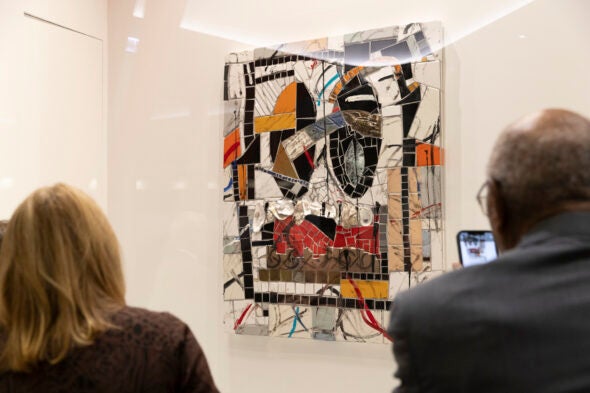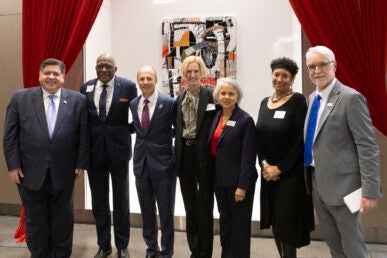UIC unveils ‘Broken Men’ artwork on campus

Combining the sharp edges of ceramic tile with the rugged surfaces of discarded objects like wood and bronze, Rashid Johnson’s “Broken Men” series articulates the anxiety of the modern world. Its block-head figures with mute expressions look like, at any given moment, they could fall apart.
Now, University of Illinois Chicago students can ponder the artist’s bemusement at an unjust society in person. University of Illinois Board of Trustees Chairman Don Edwards and his wife, Anne, have purchased one artwork from the series and agreed to display it permanently at UIC’s Academic and Residential Complex. University of Illinois System President Timothy Killeen hosted an unveiling of the artwork and a dinner at the complex Nov. 13, with UIC Chancellor Marie Lynn Miranda, Gov. JB Pritzker and others.

Cheryl Johnson-Odim, the artist’s mother and professor of history at Dominican University, attended the unveiling on her son’s behalf. As a young artist, Johnson got into trouble for tagging buildings, “places where the public could see, feel and interpret,” she said. So it was all the more fitting that his work be displayed at a public university.
In this piece from “Broken Men,” Rashid Johnson used not only ceramic tile, but pieces of mirror, oyster shells, red oak, bronze and wax. Wide eyes and a twisted mouth emerge from a chaotic mosaic. It’s both a portrait of a broken man and a chance for quiet reflection, with its mirrored surfaces.
The “Broken Men” series follows from two earlier series by Johnson, “Anxious Men” and “Anxious Audience,” which drew on his personal experience with anxiety, especially what he felt as a new dad, struggling to explain adults’ general tolerance for an unjust society, according to the artist statement alongside the piece at the Academic and Residential Complex.
“The arts give us so much — connective tissues for building cohesive societies, lenses through which we can gain new perspectives on ourselves and others, a network for communicating and sharing ideas and speaking to the vulnerable core of human beings,” Killeen said at the unveiling.
Miranda said Johnson’s “profound work has captivated art communities worldwide.”
The impact of a globally acclaimed artist being represented at a Minority-Serving Institution that has a commitment to low-income students — in a place where thousands will walk by it daily — cannot be overstated, Miranda said.
— Written by Justin Rosier
